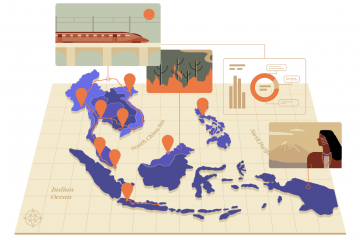Published in View from the Edge – A monthly column by Lee Han Shih, Founder of the Potato Group, featured in the CompassList newsletter. The Sailor’s Log offers analysis, insights and coverage of noteworthy trends from up-and-coming startup ecosystems. It goes out the first and third Wednesday of every month. Get the CompassList newsletter here.
If you believe the politicians, Japan is firmly on the side of the US against the rise of China. On the other hand, the flow of money – a much more honest indicator – says otherwise.
On March 23, Nikkei Asia, Japan’s oldest and most respected news portal, carried an article on Toyota. It said the carmaker – largest in Japan and among the top three in the world – has decided to make key fuel-cell components in China for its “clean” vehicles. This is the first time Toyota is making this all-important component outside of its home country. The news was confirmed by Ouyang Minggao, a professor of Tsinghua University, an expert on new energy vehicles and, most importantly, a contributor to policy formation in Beijing.
Toyota, on its part, “declined to comment” – a way of saying yes without actually saying so.
Given the tensions between the US and China and the careful role Japan is playing the second fiddle to America, Toyota’s move is a slap in the face of President Biden in his strong stance against the mainland.
Toyota is fully aware of the potential fallout of the move. But it has decided to go ahead because money from the huge Chinese market is too good to miss. In the midst of Covid-19 and finger-pointing to China last year, Toyota quietly formed a fuel-cell vehicle joint venture with a Tsinghua affiliate and a Chinese car maker.
China has vowed to go big in clean energy and the replacement of its 300m cars, trucks and buses by fuel-cell and other new energy vehicles represents a multi-trillion-dollar prize no carmaker can resist.
Having a joint venture with Tsinghua – one of the two top universities of Beijing and the traditional breeding ground for top Chinese leaders – would give Toyota a leg up in grabbing a big chunk of the market.
There is also a hidden subtext that neither Toyota nor China would mention. China is the biggest promoter and user of 5G telecom technology. 5G is the heart of the so-called fourth industrial revolution, where the widespread use of Industrial Internet of Things (IIoT) is predicted to have the same revolutionary impact in manufacturing as the previous use of water, steam and electricity. The joint venture thus allows Toyota to learn the application of IIoT first hand, and transport its learning back to Japan and its facilities in other parts of the world.
Compared to the potential gain, Toyota probably sees any fallout from the US to be a reasonable price to pay.
Where Toyota goes, others will follow. 5G manufacturing presents a host of advantages that no company, carmakers and others can ignore. It gives companies incorporating 5G IIoT much more precise control over the entire manufacturing process, higher quality and huge savings. Once a competitor gains a head start in 5G manufacturing, it would be others who stick to the old way to compete. Watch out for more Western and Japanese companies following Toyota to China.

About the author
Lee Han Shih is Founder of the Potato Productions group. He sees things from the edge and tries to stay ahead of the curve. He has been a teacher, a civil servant and a journalist. Now he’s trying to prove startups can do good and still make money.






